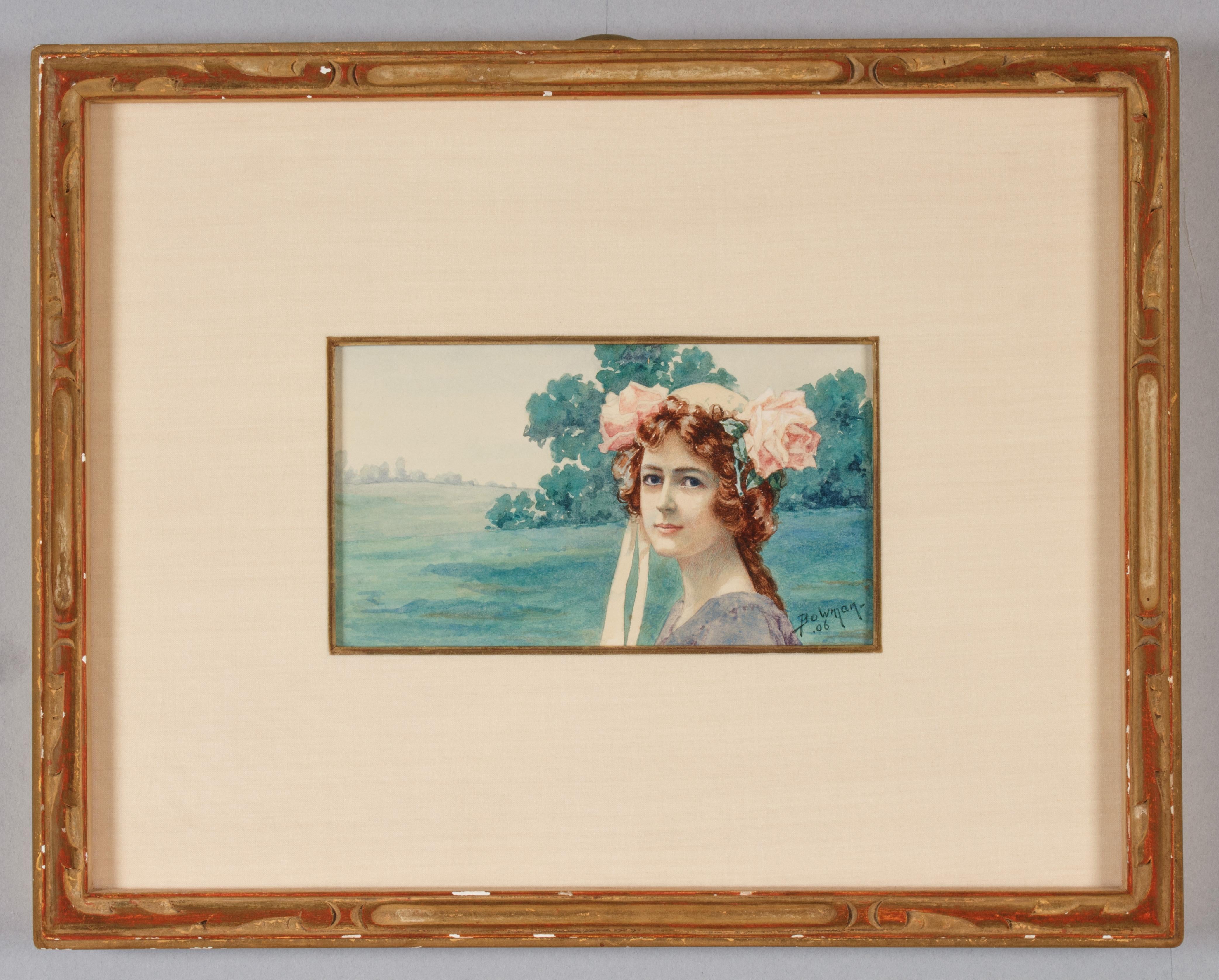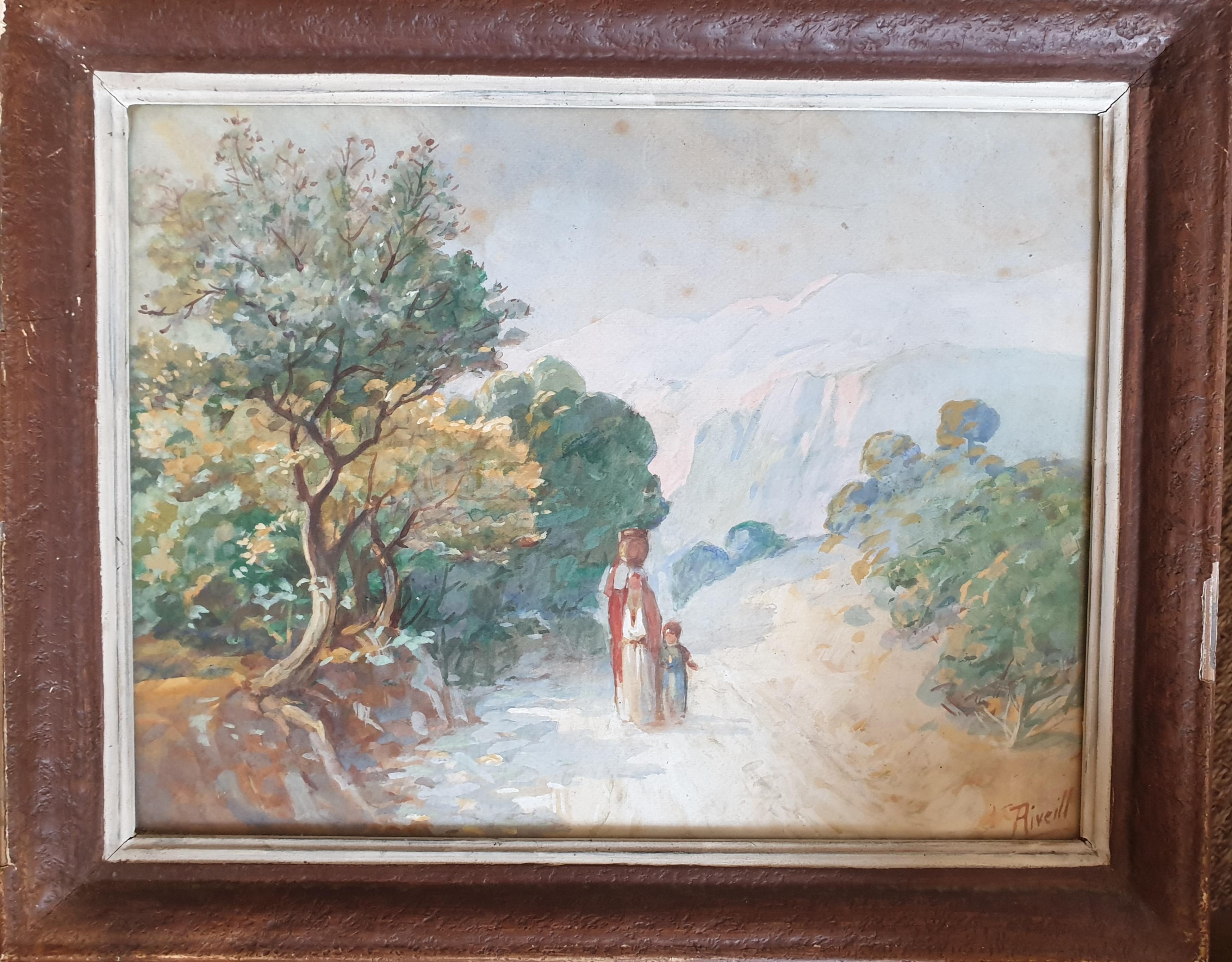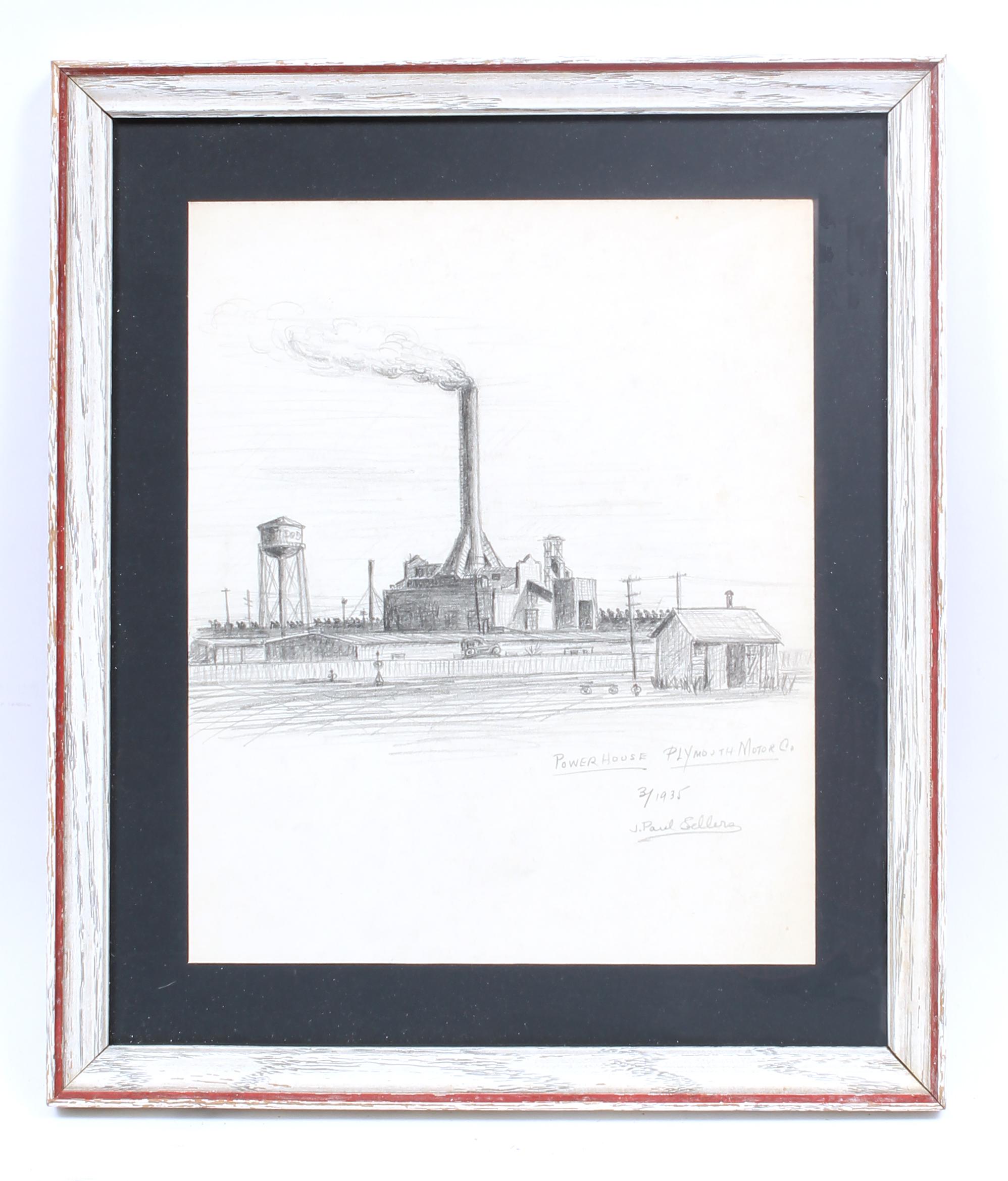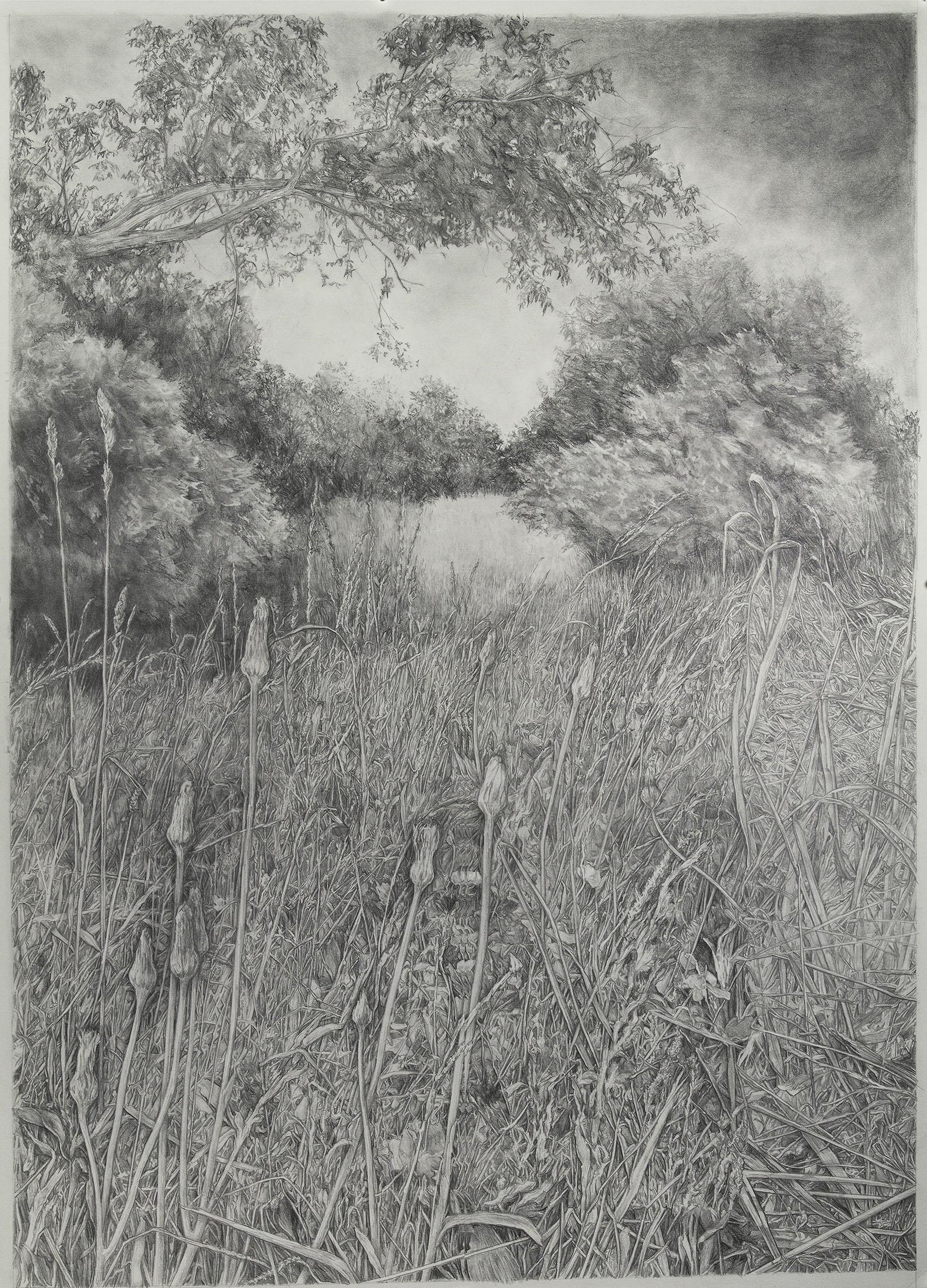Items Similar to The Ruins of St. Clement's Church in Visby, Sweden / - Real romanticism -
Want more images or videos?
Request additional images or videos from the seller
1 of 7
Otto Günther-NaumburgThe Ruins of St. Clement's Church in Visby, Sweden / - Real romanticism -c. 1900
c. 1900
About the Item
Otto Günther-Naumburg (1856-1941), The Ruins of St. Clement's Church in Visby, Sweden. Watercolor and ink, heightened with white, on sand-colored paper, mounted on cardboard, 33 x 24 cm, signed at lower left "Günther-Naumburg" and inscribed "Wisby. St. Clemens".
- At the margins remains of an old mounting, otherwise good condition.
- Real romanticism -
About the artwork
In the Middle Ages, Visby on Gotland had a total of 14 churches in a very small area, of which only the cathedral remains today. Most of the churches were destroyed in the course of the Reformation and the Danish war of succession between Christian II and Frederik I in the 16th century, so that for a long time Visby resembled a landscape of sacral ruins.
With Otto Günther-Naumburg we stand in the former choir of St. Clement's and look through the preserved triumphal arch into the ruined nave with its narthex and the remains of the façade. Although the vault is missing, the monumental arch has retained its static strength and now offers a view of the sky, so that the sacred building has in no way lost its sacred character despite its ruinous state. In the art of Caspar David Friedrich, church ruins have become a special place of longing, exuding an intense sacral aura. This romantic dimension is also found in the gate, which, although closed, offers a view of the sunset behind it. A sphere, however, that is not yet accessible to us from this side.
The brown tonality of the paper determines the appearance of the image. Starting from this basic tone, Günther-Naumburg creates the stones of the masonry with glazed black, which he skillfully accentuates with white highlights. The virtuoso green of the vegetation contrasts harmoniously with the brown, so that the viewer's gaze is constantly exploring the ruin. In addition to the romantic content of the picture, the watercolor is also a historical snapshot of how St. Clemens in Visby looked around 1900.
About the artist
Otto Günther-Naumburg, who had lived in Berlin since 1861, studied at the Berlin Academy of Arts from 1873 to 1877, first with Albert Hertel and then with his successor Christian Wilberg. From 1877 he exhibited at the Academy Exhibition, from 1891 at the Munich Glass Palace, and from 1893 at the Great Berlin Art Exhibition. Study trips took him to Southern Germany, Tyrol, Switzerland, Italy and Sweden.
Otto Günther-Naumburg developed a special mastery in watercolor painting, which he taught as a professor at the Technical University in Berlin from 1892. He also produced large-format paintings and fulfilled public commissions. He decorated the town hall of Dillingen, created the cityscapes "Posen" and "Breslau" for the Prussian House of Representatives, and designed a view of the city for the Potsdam Town Hall. In addition, Otto Günther-Naumburg worked as an illustrator for the Leipziger Illustrierte Zeitung, Daheim and the Gartenlaube, which made him widely known and appreciated.
Selected Bibliography
Thieme-Becker. Allgemeines Lexikon der Bildenden Künstler von der Antike bis zur Gegenwart, Band 15, Leipzig 1922, S. 210.
Saur. Allgemeines Künstler-Lexikon, Band 64, München - Leipzig 2009, S. 415.
GERMAN VERSION
Otto Günther-Naumburg (1856-1941), Die Kirchenruine St. Clemens im schwedischen Visby. Aquarell und Tusche, weiß gehöht, auf sandfarbenem Papier, auf Karton montiert, 33 x 24 cm, unten links mit „Günther-Naumburg“ signiert und mit „Wisby. St. Clemens“ bezeichnet.
- an den Randbereichen Reste einer alten Montage, sonst in gutem Zustand
- Reale Romantik -
zum Kunstwerk
Visby auf Gotland hatte im Mittelalter auf engstem Raum insgesamt 14 Kirchen, von denen heutzutage nur noch der Dom erhalten geblieben ist. Die meisten Gotteshäuser wurden im Zuge der Reformation und des dänischen Thronfolgestreits zwischen Christian II. und Frederik I. im 16. Jahrhundert zerstört, so dass Visby lange einer sakralen Ruinenlandschaft glich.
Mit Otto Günther-Naumburg stehen wir im ehemaligen Chor von St. Clemens und blicken durch den erhaltenen Triumphbogen in das ruinöse Langhaus, mit seiner Vorhalle und den Überresten des Fassadenaufbaus. Auch wenn das Gewölbe fehlt, hat der monumental wirkende Bogen seine statische Kraft bewahrte und gibt nun den Blick in den Himmel frei, wodurch der Sakralbau trotz seines ruinösen Zustandes keineswegs seinen sakralen Charakter verloren hat. Mit der Kunst Caspar David Friedrichs sind Kirchenruinen zu einem besonderen Sehnsuchtsort geworden, der eine intensive sakrale Aura verbreitet. Diese romantische Dimension findet sich auch in der Pforte, die zwar verschlossen ist und dennoch einen Durchblick auf den jenseitigen Sonnenuntergang freigibt. Eine Sphäre, die uns diesseitig allerdings noch nicht zugänglich ist.
Die Brauntonalität des verwendeten Papiers bestimmt die Erscheinung des Bildes. Von diesem Grundton ausgehend, kreiert Günther-Naumburg mit lasierend aufgetragenem Schwarz die Steine des Gemäuers, die er gekonnt durch Weißhöhungen akzentuiert. Mit dem Braun tritt das virtuos gesetzte Grün der Vegetation in einen harmonischen Kontrast, so dass der Blick immer wieder von Neuem die Ruine erkundet. Neben dem romantischen Gehalt des Bildes ist das Aquarell zugleich eine historische Momentaufnahme wie S. Clemens in Visby um 1900 ausgesehen hat.
zum Künstler
Ab 1861 in Berlin ansässig, studierte Otto Günther-Naumburg von 1873-1877 an der Berliner Akademie der Künste, zunächst bei Albert Hertel und dann unter dessen Nachfolger Christian Wilberg. Von 1877 an beschickte er die Akademie-Ausstellung, ab 1891 war er im Münchner Glaspalast vertreten und ab 1893 wurden Werke von ihm auf der Großen Berliner Kunstausstellung gezeigt. Studienreisen führten ihn nach Süddeutschland, Tirol, Schweiz, Italien und nach Schweden.
Eine besondere Meisterschaft entwickelte Otto Günther-Naumburg in der Aquarellmalerei, die er ab 1892 als Professor an der Technischen Hochschule Berlin lehrte. Er fertigte aber auch großformatige Gemälde an und kam öffentlichen Aufträgen nach. So stattete er unter anderem den Rathaussaal von Dillingen aus, schuf für das Preußische Abgeordnetenhaus die Städtebilder ‚Posen‘ und ‚Breslau‘ und gestaltetet für das Potsdamer Rathaus eine Ansicht der Stadt. Zudem war Otto Günther-Naumburg als Illustrator für die Leipziger illustrierte Zeitung, Daheim und die Gartenlaube tätig, wodurch er weithin bekannt und geschätzt wurde.
Auswahlbibliographie
Thieme-Becker. Allgemeines Lexikon der Bildenden Künstler von der Antike bis zur Gegenwart, Band 15, Leipzig 1922, S. 210.
Saur. Allgemeines Künstler-Lexikon, Band 64, München - Leipzig 2009, S. 415.
- Creator:Otto Günther-Naumburg (1856 - 1941, German)
- Creation Year:c. 1900
- Dimensions:Height: 13 in (33 cm)Width: 9.45 in (24 cm)Depth: 0.4 in (1 cm)
- Medium:
- Movement & Style:
- Period:
- Condition:
- Gallery Location:Berlin, DE
- Reference Number:1stDibs: LU2438212631852

About the Seller
5.0
Vetted Seller
These experienced sellers undergo a comprehensive evaluation by our team of in-house experts.
Established in 2014
1stDibs seller since 2023
7 sales on 1stDibs
Typical response time: 7 hours
- ShippingRetrieving quote...Ships From: Berlin, Germany
- Return PolicyA return for this item may be initiated within 14 days of delivery.
More From This SellerView All
- Evening Cottage Scene / - Somewhere in Nowhere -Located in Berlin, DEArthur Claude Strachan (1865 Edinburgh - 1954 Minehead), Evening Cottage Scene. Watercolor on paper, mounted, 28 x 46 cm (visible size), 48 x 65 cm (fra...Category
Early 1900s Realist Landscape Drawings and Watercolors
MaterialsPaper
- Shady hollow way - Into the heart of the forest -By Hans DvoràkLocated in Berlin, DEHans Dvořák (19th century). Shady hollow way in a sunny forest. Watercolour and pen-and-ink drawing, 58.5 x 43 cm (visible size), 70 x 55.5 cm (frame), signed and dated "Hans Dvořák ...Category
1880s Realist Landscape Drawings and Watercolors
MaterialsWatercolor
- High Moorland Landscape in the fog - The world as a transcendent phenomenon -Located in Berlin, DECharles Edward Brittan Jr (1870 Plymouth - 1949). High moor landscape in the fog. Gouache, signed at lower left "Charles E. Brittan", 18 x 34.5 cm (passepartout), 45 x 62 cm (frame)....Category
Early 20th Century Realist Landscape Drawings and Watercolors
MaterialsWatercolor
- Red blooming war landscape with dead soldier - Bleeding flowers -Located in Berlin, DEJohannes Friedrich Heinrich Hänsch (1875-1945), Red blooming war landscape with dead soldier, 1918. Watercolor and gouache on paper, 15 x 24.5 cm (image), 27 x 37 cm (sheet size / frame), monogrammed and dated "19JH18" at lower left. - Paper slightly darkened About the artwork Despite the relatively small format, the watercolor with an internal frame depicts a panoramic view of a flat landscape stretching to the horizon. As far as the eye can see, the poppies bloom in flaming red. The flowers are not rendered individually, however, creating an almost cohesive red surface. The bright red is interspersed with vegetal green. A complementary contrast that creates an intense color effect. In this color contrast, a white area breaks through from the middle ground, widening towards the foreground and surrounding a brown hole. Next to it, in blue, is the actual protagonist of the painting, the first thing that catches the eye: a dead soldier. Next to him is his helmet, revealing the empty interior. The brown, hollow shape corresponds to the hole in the ground. A shell funnel is surrounded by bright ash, which, like the inverted helmet, becomes a sign of death. The soldier's arms point to the funnel, while the empty helmet paraphrases the calotte of the skull and, like the funnel, thematizes the empty darkness of death. The soldier's body, however, is intact and not - as in Otto Dix's triptych "The War" - a dismembered corpse. Instead, Johannes Hänsch activates the landscape, especially the color, to illustrate a blooming landscape of death that extends from the shell funnel in the foreground to the rising column of smoke on the horizon. If the soldier's body is intact, the tangle of barbed wire emblematically placed over the empty helmet also appears tattered. On the right side of the picture, the barbed wire even seems to stretch its arms to the sky in horror. Against the background of this allegory, the content of the bright red also becomes clear: the landscape is drenched in blood, literally a sea of blood, and the single unknown soldier stands pars pro toto for all those who died on the battlefield. Dying in war is not dying in community, but in solitude. In order to emphasize the isolation in death, Johannes Hänsch has set the blue of the soldier in the axis given by his body in the middle ground of the picture into the red sea. A master of landscape painting, Hänsch succeeds in creating a natural-looking landscape allegory that illustrates the horror and death of war, without depicting the brutality of war itself. This singular 'war memorial' of the unknown soldier is the opposite of heroization and yet the dignity of the deceased soldier is preserved through the integrity of his body. About the artist As the son of the sculptor Adolf Haensch, the young Johannes received his first artistic training in his father's Berlin studio. However, he eventually decided to become a painter, and in 1897 he entered the Berlin Academy of Arts. He initially studied under Paul Vorgang and Eugen Bracht, and was particularly influenced by Bracht's increasingly colourful landscape painting. In 1901 he moved to the class of Friedrich Kallmorgen, with whom he spent several weeks on excursions into nature. In 1905 he became a master pupil of Albert Hertel, who taught him watercolour painting. From 1903 to 1933 he exhibited annually at the Great Berlin Art Exhibition, the exhibitions of the Berlin Artists' Association and the Munich Glaspalast. In 1905 he was awarded the Carl Blechen...Category
1910s Realist Figurative Drawings and Watercolors
MaterialsWatercolor
- Wettersteinkamm - The blue of the mountains -Located in Berlin, DEAdalbert Holzer (1881 Munich - 1966 Munich). Wettersteinkamm. Watercolour, 29 x 34.5 cm (visible size), 37.5 x 43 cm (frame), signed and dated at lower right 'ADALBERT HOLZER [19]23'. Framed behind glass. Frame shows signs of wear. - The blue of the mountains - About the artwork The Wetterstein ridge is revealed to the viewer from a gentle, snow-covered hill. In contrast to conventional depictions of mountains, the painting is composed entirely of shades of blue, which condense into the blue-grey of the rock or fade into the white of the snow. As a complementary colour to the blue, Holzer virtuously activates the ochre ground. The uniform yet exciting polarity of the colours emphasises the massive majesty of the mountains and at the same time underlines the special character of the Wetterstein ridge. Holzer transferred the translucency of glass painting, in which he was originally trained, to watercolour and developed a pictorial language related to the art of Ferdinand Hodler, which earned him the nickname 'Master of Blue' and led to the appreciation of his watercolours in particular. About the artist After an apprenticeship as a stained glass painter at the Kunstgewerbeschule, Adalbert Holzer studied at the Munich Art Academy under Carl von Marr...Category
1920s Realist Landscape Drawings and Watercolors
MaterialsWatercolor
- Wind Dodgers at the Baltic SeaLocated in Berlin, DETheodor Scheerbaum (1897 Reichenbach im Vogtland), Wind Dodgers at the Baltic Sea. Watercolor on strong yellowish grained paper, 44 x 56 cm, signed by hand "Th[eodor] Scheerbaum" at ...Category
1950s Realist Landscape Drawings and Watercolors
MaterialsWatercolor
You May Also Like
- Watercolor Portrait of a Girl with Roses signed Bowman 1906Located in Philadelphia, PAUnknown Artist (Bowman) (early twentieth century) Girl with Roses Watercolor on paper, 5 x 8 inches Framed: 13 x 16 inches Signed and dated at lower right: “Bowman/.06”Category
Early 1900s Realist Landscape Drawings and Watercolors
MaterialsPaper, Watercolor
- The Chestnut Vendor: an early 20th century Italian watercolor signed A.MattoliniLocated in Philadelphia, PAA. Mattolini (Italian, early twentieth century) The Chestnut Vendor Watercolor on paper, 12 3/4 X 9 inches Signed at lower left: “A Mattolini”Category
Early 20th Century Realist Figurative Drawings and Watercolors
MaterialsWatercolor, Paper
- The Watercarrier, Orientalist Watercolour.Located in Cotignac, FREarly 20th century orientalist watercolour on paper by Aiveill, signed bottom right. In art history, Orientalism is the imitation or depiction ...Category
Early 20th Century Realist Landscape Drawings and Watercolors
MaterialsPaper, Watercolor, Gouache
- Notre-Dame de Paris. Paper, watercolor, 26.5x18 cmBy Edward NevilLocated in Riga, LVEdward Nevil ( 1813 – 1901 ) Notre-Dame de Paris. Paper, watercolor, 26.5x18 cmCategory
Mid-19th Century Realist Landscape Drawings and Watercolors
MaterialsPaper, Watercolor
- Modern American Industrial Drawing Factory Graphite Framed Black and WhiteLocated in Buffalo, NYA fantastic industrial drawing dated 1935, which depicts the former Plymouth Motor Company's Powerhouse in Buffalo, NY. Housed in a contemporary frame presentation this unique work ...Category
1930s Realist Landscape Drawings and Watercolors
MaterialsPaper, Graphite
- Conceptual Realist Drawing Floral Wheat Delicate Detailed American female artistBy Amanda BeslLocated in Buffalo, NYAn original contemporary graphite drawing by American contemporary female artist Amanda Besl. Diana's Field 2, 2018 Graphite on paper 34 × 24 in 86.4 × 61 cm This work was created ...Category
2010s Realist Figurative Drawings and Watercolors
MaterialsGraphite, Paper




